Chalk Bed Marine Conservation: lessons from the UK
A case study from the Cromer Shoal Chalk Beds Marine Conservation Zone (MCZ), featured in our latest Protected Areas In-Sight Journal, that is available in English, German and French.
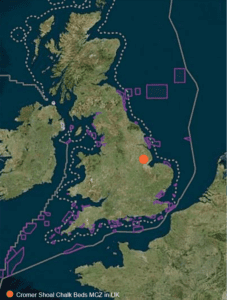
Cromer Shoal Chalk Beds MCZ in UK. Copyright JNCC.
Article issued by Fiona Tibbitt – Marine Lead Adviser at Natural England
Natural England (NE) provides conservation advice to regulators of fishing activities in English waters, with a special focus on Marine Protected Areas.
Cromer Shoal Chalk Beds MCZ in North Norfolk was designated in 2016 under UK legislation The Marine and Coastal Access Act (MACAA) of 2009. The aim of MACAA 2009 is to protect rare, threatened and representative habitats, species and geological features of national importance. This legislation is unique – it considers ecological and geological importance as well as socio-economic impacts. Local communities and sea bed users had a say in the designation process and those views were listened to. A decade later, we are much closer to a well-managed, ecologically coherent network of Marine Protected Areas, but there’s still work to do.
Chalk beds are important because their cracks and crevices provide refuge for wildlife, especially juvenile invertebrates and fish. It is also a source of substrates for burrowing organisms. Any irreparable structural damage is therefore significant and may require some sort of management.
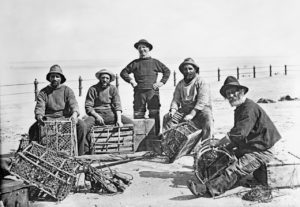
Historical Cromer Crab and Lobster fishery.
Copyright National Maritime Museum
The assessment of fisheries impact to create management measures in Cromer Shoal Chalk Beds MCZ is now underway. But when the site was designated, we had limited evidence. Fisheries activity levels were unclear and the position of Natural England (NE) was that the most intensive fishing activity – ‘potting’ – was small scale, selective and low impact. Based on the best available evidence at that time, implementation of management measures was unlikely and this was communicated widely.
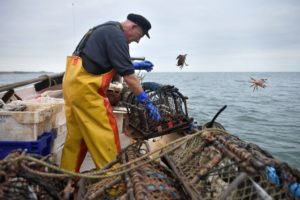
Cromer Crab and lobster fishery today. Copyright Romsey Advertiser.
Currently, new anecdotal evidence shows that there may be impacts on chalk habitats from some fishing activities after all. But given the rarity of this habitat, we still need more evidence to improve our understanding.
Chalk Bed Marine Conservation: reconciling the regional heritage with sustainable management
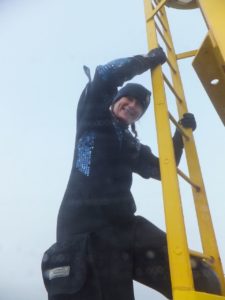
Fiona Tibbitt
The crab and lobster fishery started in the 19th century and is fundamental to the character, cultural heritage and economy of North Norfolk, so it is essential that any management is risk-based and proportionate. The application of the ‘precautionary principle’ is required where evidence is lacking and NE advise an ‘adaptive management approach’. This means, with more evidence, management can be modified accordingly.
NE are working closely with the conservation authorities and the Agents of Change Project, Marine Conservation Society at the Essex University, fisheries representatives and Seasearch to gather more evidence. We have conducted dive and drone surveys, workshops and discussions to improve understanding of activities and impacts on chalk. Novel techniques are being used, e.g. 3D Photogrammetry to improve our scientific understanding and provide tools for exciting marine visualisation opportunities for education and outreach purposes, such as Virtual underwater tours.
Community Voice Method workshops with fishers outlined plans for more to be done in terms of gathering evidence and communicating the findings. Plans for a fishers and regulators forum are evolving so fishers are included in the management and feel a sense of ownership. Local communities also need to be involved as they can act as local monitors, and resources for enforcement will always be finite.
The Community Voice Method is an innovative, research-based approach to fostering effective public conversations about important local issues. It aims to foster more inclusive, informed, and ongoing civic dialog in communities facing changes to their landscapes and resource-based livelihoods.
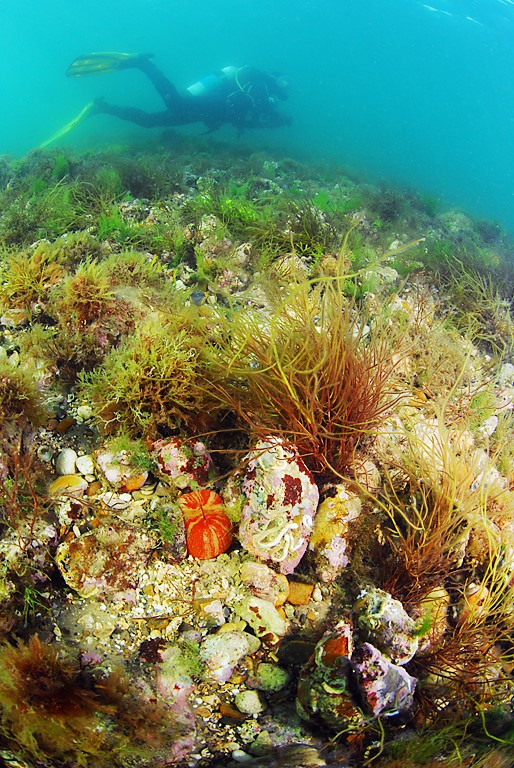
Diver on Cromer Shoal MCZ. Copyright Sam Bean.
Further work to help build trust between us and the local community is needed with better and regular communications. Sustainability is at the heart of management of Marine Protected Areas but both the marine environment and coastal communities need to be addressed, so they can thrive together.
This approach is being watched closely by others as there are implications for other chalk sites elsewhere. It will be precedent setting and we need to get it right.
So can we consider it a success?
We have achieved adaptive, proportionate and effective management. There is a thriving and sustainable local fishery with other sustainable marine activities and an engaged local community protecting their MCZ for future. With our partners, we help gather science and evidence to assess the condition of our MCZ in order to better inform the management and help to modify it accordingly. Finally, the public are engaged in innovative ways so they connect, value and respect the Cromer Shoal Chalk Beds MCZ. There’s still much work to do, but we’ll get there.

Fiona Tibbitt – Marine Lead Adviser, Natural England